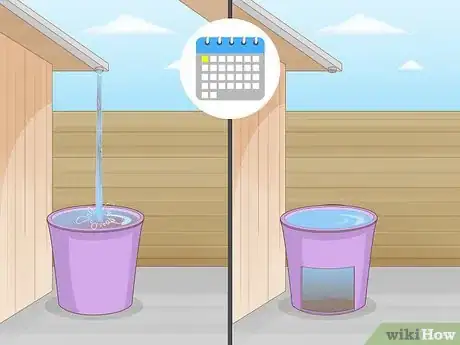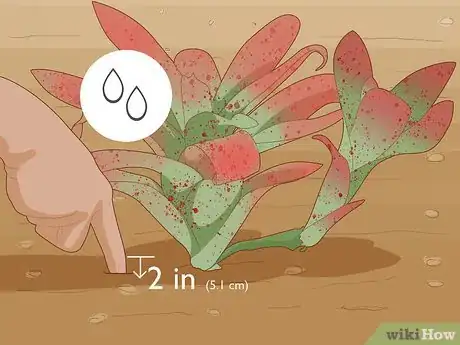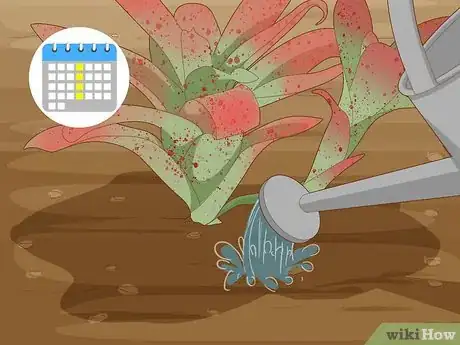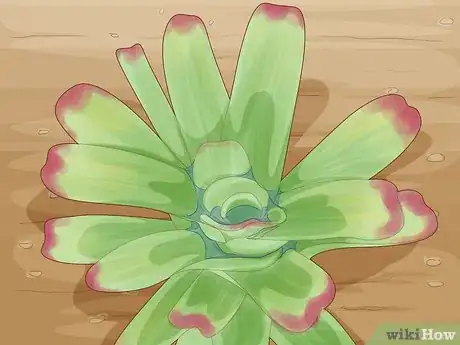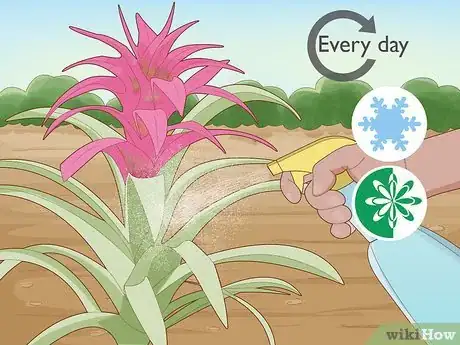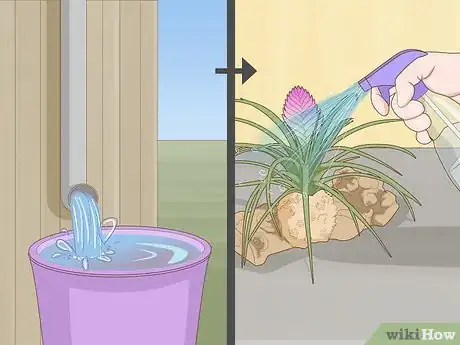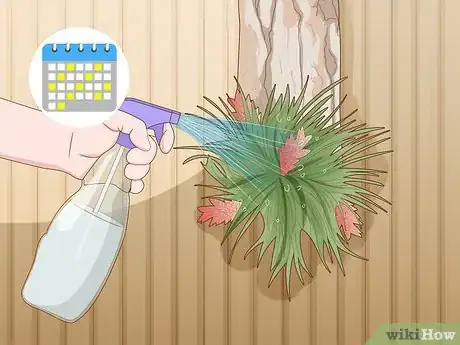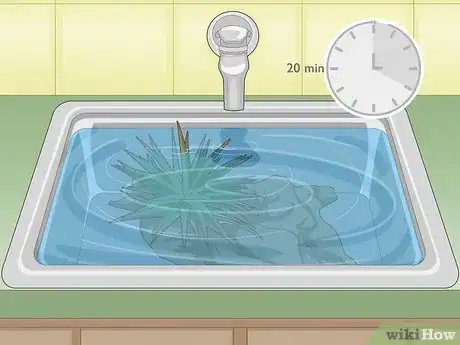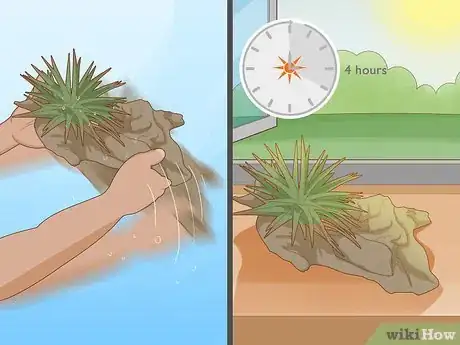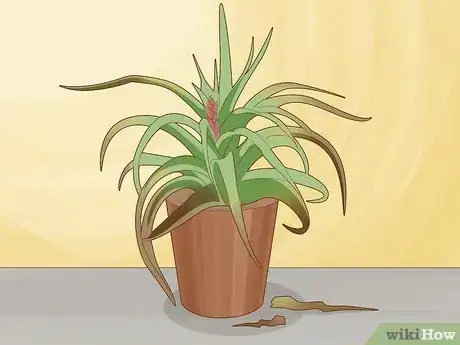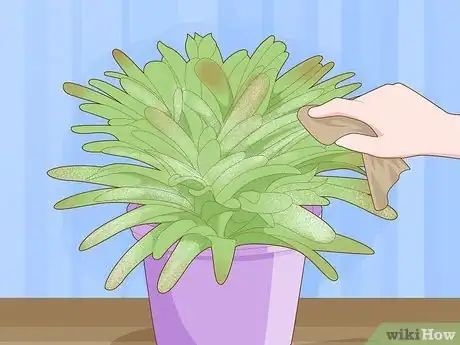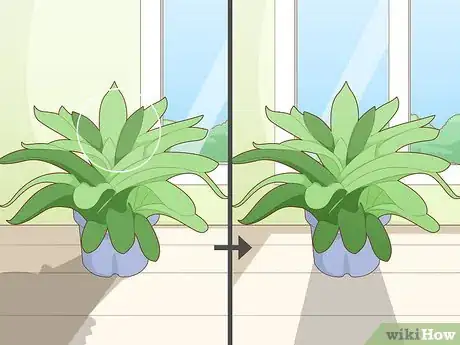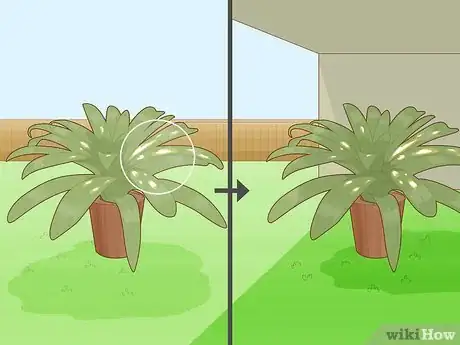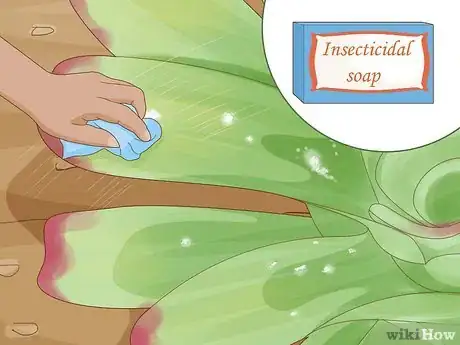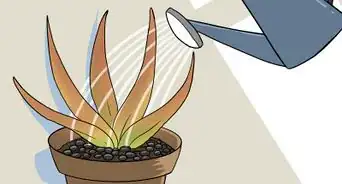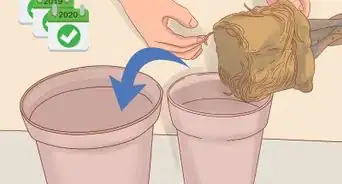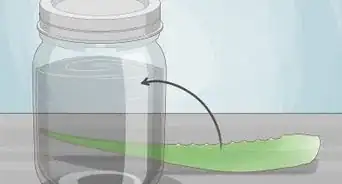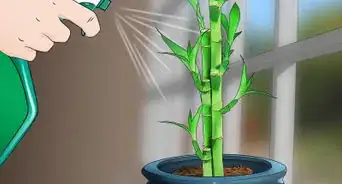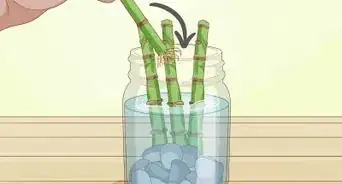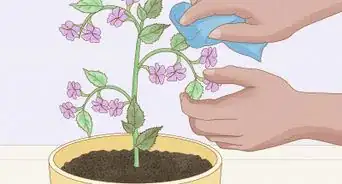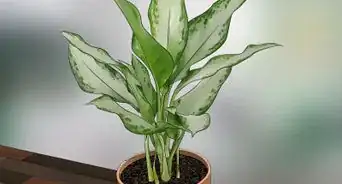This article was co-authored by wikiHow Staff. Our trained team of editors and researchers validate articles for accuracy and comprehensiveness. wikiHow's Content Management Team carefully monitors the work from our editorial staff to ensure that each article is backed by trusted research and meets our high quality standards.
There are 13 references cited in this article, which can be found at the bottom of the page.
This article has been viewed 11,215 times.
Learn more...
Bromeliad plants add an exotic touch to your home with their unique shape and vibrant colors. They’re native to tropical and subtropical regions, so they don’t need much water to survive. Rainwater is best because it mimics their natural environment. If you have an air bromeliad growing on a piece of wood or other structure, you’ll need to water them differently than other plants. Look to the leaves to see if your bromeliad is happy with how much water and light you’re giving it.
Steps
Watering Potted or Garden Bromeliads
-
1Collect rainwater to water your bromeliad plant, if possible. Bromeliads do best with natural rainwater because it doesn't contain chemicals that may be found in tap water. To get rainwater, place a plastic bucket or glass jar outside (with a collection funnel) and let it fill up during the next downpour.[1]
- Don't use a metal bucket because metallic elements seeping into the water can harm the plant.
- If you can't gather rainwater, let tap water sit for a day or 2 before using it to water the plant so that some of the chlorine and lime can evaporate.
- Avoid using purified or distilled water because the use of reverse osmosis filters out a lot of the minerals that bromeliad plants need to thrive.
-
2Test the top 2 in (5.1 cm) of soil for potted or outdoor plants. Before you water your potted or garden bromeliad, always stick your finger into the soil to feel for moisture. If you don't detect any moisture in the top 2 in (5.1 cm) of soil, wait another day or 2 before checking it again.[2]
- Bromeliads are generally very tolerant of droughts and don’t like to be overwatered.
Advertisement -
3Pour water directly onto the soil every 7 days or when it’s dry. It’s better to underwater bromeliads than overwater them, so be frugal with the amount of water you use. For potted plants, stop when you see the first sign of water draining from the drainage holes.[3]
- For plants in the ground, stop watering when the top layer of soil is moist.
-
4Fill the center tank of the bromeliad if it has one and don’t let it go dry. The tank is located at the center where the convex-shaped leaves meet in a rosette pattern. You should fill this cup and let the water spill out onto the soil around the base of the plant.[4]
- Rinse out the tank once a week by pouring the water into a bowl or cup.
- It's important to rinse and replace the tank area because stagnant water can cause salt to build up and damage the plant.
-
5Mist the leaves of potted plants every day during winter and spring. Bromeliads love atmospheric moisture, so fill a spray bottle with rainwater to mist the leaves every day during the winter and spring. Whenever the air is dry, your bromeliad will appreciate a misting.[5]
- As an alternative, place the planter over a saucer filled with rainwater. Place rocks in the saucer to hold the base of the planter above the surface of the water.
Watering Air Bromeliads
-
1Use rainwater to water your air bromeliad. Keep a bucket or large plastic container outside to collect fresh rainwater. It’s better for bromeliads because it doesn’t contain trace metals and other chemicals found in tap water.[6]
- Use only plastic or glass containers to collect rainwater—metal containers will taint the water and hurt the plant.
- As an alternative, take water from the faucet and let it sit for 1 to 2 days. Some of the chemicals will evaporate out of the water, making it more suitable for the plant.
- Distilled or purified bottled water doesn’t have certain minerals your plant needs, so don’t use these types.
-
2Spray air bromeliads with rainwater every 1 or 2 days. Air plants (like plants of the Tillandsia genus) typically cling to vertical or rocky surfaces and get their nutrients from the air. However, they still need to be misted with water every day or 2 to ensure they get enough moisture and humidity.[7]
- After misting, put the plant on a towel to dry for 2 to 3 hours if you don't want water dripping down from wherever you keep the plant.
- If you notice the leaves curling up around the edges, it’s time to water your air plant.
-
3Soak air plants in a bowl or sink for 20 minutes each week. If you have a small air bromeliad, soaking it every week is an easy way to keep it happy. Don't worry about giving it too much water because air plants only take in the moisture they need. During the winter, decrease the frequency to once every 3 weeks.[8]
- If your air plant has bloomed, don’t soak the flowers because it could cause them to rot.
-
4Shake off excess water and let the plant dry for 4 hours in a sunny spot. After removing the plant from the water bath, gently shake off any excess water. Turn it upside down and to each side to remove as much moisture as you can. Find a bright, sunny spot outside and leave the plant there for 4 hours until it’s completely dry.[9]
- Any excess water left on the plant or in the crevices of its leaves can cause the small cores to rot.
Troubleshooting Bromeliad Issues
-
1Watch out for soggy, brown leaves or rapid shedding. These are all signs of heart rot, which is caused when the plant is drastically overwatered or has drainage issues (that is, the roots are sitting in water). If you notice these symptoms, replant the pot in fresh soil and ease up on your watering schedule.[10]
- Use a well-draining soil made from peat, bark, and sand.
- Make sure to choose a pot with large drainage holes in the bottom.
- If only a small spot on the leaf is brown or soggy, you may be able to fix the issue by watering it less.
- You may also want to move the plant to a drier environment or a place with better air circulation.
-
2Wipe away salty or chalky residue on the leaves. If you notice the leaves have a white, salty buildup on them, wipe the leaves with a rag moistened with rainwater. This residue is caused by watering the plant with tap water.[11]
- The salts in the residue can eat away at root tissues and affect the plant's ability to take in nutrients.
- This residue can also appear as a sign of over-fertilizing.
-
3Revive a dry bromeliad by soaking it for 5 to 8 hours every 2 or 3 days. If your air bromeliad looks extra dry or wilted, fill a tub or large bowl with rainwater and let it soak for 5 to 8 hours. Take it out and let it dry in a well-ventilated area for 4 hours before putting it back in its place.[12]
- Do this every 2 to 3 days until your air bromeliad is looking happy and healthy again.
-
4Move the plant to a place with more light if the leaves turn dark green. Species of bromeliad that have sturdy leaves love high levels of indirect light. However, any type of bromeliad can turn green as a way to compensate for the lack of sunlight. If your bromeliad currently has little to no light, gradually move it closer to a window or a place with bright indirect light.[13]
- Don’t move it from dark to light right away because such a drastic change may burn the leaves.
- Aechmea, Tillandsia, and Neoregelia do best with bright indirect light.
-
5Withhold bright light if the leaves develop bleached spots. Inspect the leaves of your bromeliad every few days to see if it’s happy with the amount of light. If you see white spots anywhere on the leaves, move it to a place that gets less light.[14]
- For instance, if your bromeliad is near a window and has white spots, move it to a table or side table in a dimly-lit hallway or room.
- Plants with soft leaves like Guzmania and Vriesea enjoy low levels of indirect light.
-
6Fertilize limp or wilting plants once a month during summer months. Use a liquid fertilizer (17-8-22 blend) and dilute it with rainwater to 1/4 of its strength. If you're using pellets, use 1/4 of the amount recommended on the package and lightly sprinkle them on the soil of potted plants.[15]
- Don't place fertilizer inside the bromeliad's tank because it can burn the leaves and may cause rotting.
- If you notice the leaves losing their color, you're over-fertilizing the plant.
- For air plants, mist the leaves with specialty spray fertilizer (17-8-22 blend).
-
7Rub the leaves with insecticidal soap to remove and deter pests. Dampen a rag with insecticidal soap or rubbing alcohol and rub the leaves to remove the pests. The smell and the chemicals will deter them from coming back.[16]
- If you have multiple bromeliads, keep the infested one far away from the others to prevent the pests from spreading.
- Mealybugs and mites commonly show up on bromeliad plants, especially if they’re placed outdoors.
- You can find insecticidal soap or spray at most nurseries or garden supply stores.
Warnings
- Do not let the base of potted plants sit in water because it will cause the roots to rot.[19]⧼thumbs_response⧽
References
- ↑ https://www.bromeliads.info/best-water-for-plants/
- ↑ https://www.apartmenttherapy.com/bromeliad-plant-tips-for-growing-propagating-and-care-237764
- ↑ https://www.apartmenttherapy.com/bromeliad-plant-tips-for-growing-propagating-and-care-237764
- ↑ https://asknature.org/strategy/leaves-capture-water-2/
- ↑ https://www.apartmenttherapy.com/bromeliad-plant-tips-for-growing-propagating-and-care-237764
- ↑ https://www.bromeliads.info/best-water-for-plants/
- ↑ https://youtu.be/95nlQ7yPvbA?t=50
- ↑ https://gardentherapy.ca/water-air-plants/
- ↑ https://www.sunset.com/garden/keep-your-air-plant-alive-with-these-6-simple-tricks-tillandsia
- ↑ https://www.bromeliads.info/troubleshooting-bromeliad-problems/
- ↑ https://www.bromeliads.info/flush-out-excess-fertilizer-salts/
- ↑ http://blogs.ifas.ufl.edu/nassauco/2017/05/29/fact-sheet-bromeliad/
- ↑ https://www.bromeliads.info/caring-for-bromeliads-part-one-light/
- ↑ https://www.bromeliads.info/caring-for-bromeliads-part-one-light/
- ↑ https://www.bromeliads.info/caring-for-bromeliads-part-three-fertilizer/
- ↑ https://www.bromeliads.info/common-bromeliad-pests/
- ↑ https://www.gardeningknowhow.com/houseplants/bromeliad/growing-bromeliad-plants.htm
- ↑ http://blogs.ifas.ufl.edu/nassauco/2017/05/29/fact-sheet-bromeliad/
- ↑ http://blogs.ifas.ufl.edu/nassauco/2017/05/29/fact-sheet-bromeliad/
